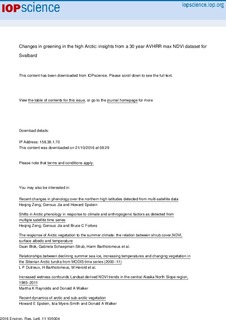| dc.contributor.author | Vickers, Hannah | |
| dc.contributor.author | Høgda, Kjell Arild | |
| dc.contributor.author | Solbø, Stian | |
| dc.contributor.author | Karlsen, Stein Rune | |
| dc.contributor.author | Tømmervik, Hans | |
| dc.contributor.author | Aanes, Ronny | |
| dc.contributor.author | Hansen, Brage Bremset | |
| dc.date.accessioned | 2016-11-02T12:46:15Z | |
| dc.date.accessioned | 2016-11-08T13:01:44Z | |
| dc.date.available | 2016-11-02T12:46:15Z | |
| dc.date.available | 2016-11-08T13:01:44Z | |
| dc.date.issued | 2016 | |
| dc.identifier.citation | Environmental Research Letters 2016 | nb_NO |
| dc.identifier.issn | 1748-9326 | |
| dc.identifier.uri | http://hdl.handle.net/11250/2420133 | |
| dc.description.abstract | Satellite-aided studies ofvegetation cover, biomass and productivity are becoming increasingly
important for monitoring the effects ofa changing climate on the biosphere. With their large spatial
coverage and good temporal resolution, space-borne instruments are ideal to observe remote areas over
extended time periods. However, long time seriesdatasets with global coverage have in many cases too
lowspatial resolution for sparsely vegetated high latitude areas. Thisstudy has made use ofa newly
developed 30 year 1 kmspatial resolution dataset from 1986 to 2015, provided bythe NOAAAVHRR
series ofsatellites, in order to calculate the annual maximum NDVI over parts of Svalbard
(
78
°
N
)
.This
parameterisindicative ofvegetation productivity and has therefore enabled usto study long-term
changes in greeningwithin the Inner Fjord Zone on Svalbard. In addition, local meteorological data are
availabletolinkmaximumNDVIvaluesto the temporalbehaviorofthe meangrowingseason
(
summer
)
temperature for the study area. Overthe 30 yearperiod, we
fi
nd positive trends in both maximum NDVI
(
average increase of29%
)
and mean summer temperature
(
59%
)
, which were signi
fi
cantly positively
correlated with each other.Thissuggests a temporal greening trend mediated by summer warming.
However, as also recently reported for lower latitudes, the strength ofthe year-to-year correlation
between maximum NDVI and mean summer temperature decreased, suggestingthatthe response of
vegetationto summer warming has not remainedthe same overthe entire study period. | nb_NO |
| dc.language.iso | eng | nb_NO |
| dc.publisher | IOP Publishing | nb_NO |
| dc.rights.uri | https://creativecommons.org/licenses/by/3.0/ | |
| dc.subject | reduced greening trend, satellite observations of vegetation, 30 year time series of NDVI on Svalbard, effects of warming on vegetation productivity | nb_NO |
| dc.title | Changes in greening in the High Arctic - insights from a 30-year AVHRR max NDVI dataset for Svalbard | nb_NO |
| dc.type | Journal article | nb_NO |
| dc.type | Peer reviewed | nb_NO |
| dc.date.updated | 2016-11-02T12:46:15Z | |
| dc.source.volume | 11 | nb_NO |
| dc.source.journal | Environmental Research Letters | nb_NO |
| dc.identifier.doi | 10.1088/1748-9326/11/10/105004 | |
| dc.identifier.cristin | 1386686 | |
| dc.description.localcode | Original content from this work may be used under the terms of the Creative Commons Attribution 3.0 licence . Any further distribution of this work must maintain attribution to the author ( s ) and the title of the work, journal citation and DO | nb_NO |

